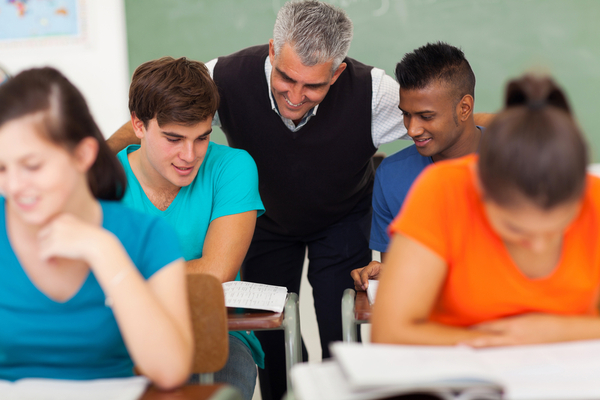Trauma comes in many forms, from living in extreme poverty or neglect, to experiencing difficult events like bullying, school shootings, community violence, or physical or sexual violence, to divorce or death of a loved one. In recent years, societal shifts have highlighted additional sources of trauma, such as cyberbullying and online harassment, climate-related disasters, and the growing mental health crisis among youth.
For students to learn and thrive, schools need to create an environment where students feel safe and valued. By understanding the importance of mental health and relationship-building and building a culture of respect and support, schools can help students reach their full potential. Not only do trauma-informed schools improve outcomes for individual students, they also affect other students, teachers, and the school community.
What is a Trauma-Informed School?
In a trauma-informed school, teachers and other adults in the school community recognize and adjust teaching and administrative strategies to help students affected by trauma. For educators, practicing trauma-informed approaches calls for a shift in thought from “what’s wrong with you?” to “what happened to you, and how can I help?” Trauma-informed approaches positively impact all students, not just students affected by trauma.
How Does Trauma Affect Students?
Adverse childhood experiences create a lasting impact on students. Not all people react to abuse in the same way. When a person experiences fear or trauma, the sympathetic nervous system prepares the body. This is called a “fight or flight” reaction. Once the danger is over, the parasympathetic nervous system takes over and returns the body to its natural state. If a person is in a constant state of stress, it is very stressful for the body and can cause health issues.
Victims who experience this will show symptoms of either “high emotions” or “shutting down,” depending on how they react.
High emotions:
- Anger
- Panic or phobia
- Irritability
- Hyperactivity
- Crying or temper tantrums
- Regressive behavior (acting younger than they are)
- Nightmares or terrors
- Clingy behavior
- Running away (fight or flight)
Shutting down:
- Daydreaming
- Inability to bond with others
- Inattention or forgetfulness
- Shyness
- Pale skin
- Complaints of being cold
- “Flat” affect
A stressed brain can’t focus. Trauma is a barrier to learning and can cause:
- Trouble concentrating or staying on task
- Acting out (although quiet children that don’t show problem behaviors can go undetected)
- Decreased reading ability
- Lower GPA
- Higher rates of absenteeism
- Higher dropout rate
- Risky behaviors like smoking, substance abuse, and unprotected sex
- Chronic stress, which can change brain development and affect decision-making and how someone responds to stress
How Do Trauma-Informed Schools Help?
According to the National Association of School Psychologists, trauma-informed schools promote:
- Feelings of physical, social, and emotional safety in students
- A shared understanding among staff about the impact of trauma and adversity on students
- Positive and culturally responsive discipline policies and practices
- Access to comprehensive school mental and behavioral health services
- Effective community collaboration
By implementing trauma informed practices, schools can create a positive, supportive space and encourage students’ resilience, leading to:
- Improved behavior
- Fewer suspensions and expulsions
- Improved academic performance
- Reduced emotional distress
What Does a Trauma-Informed School Look Like?
Bonding and Developing Trust in the Classroom
Educators and administrators can:
- Create positive relationships with students. Ask questions and be engaged in their interests.
- Listen to your students, acknowledge their feelings, and respond intentionally.
- Create a positive physical space in the classroom, with colorful posters, plants, and art.
- Be predictable by creating routines and visual schedules to anchor students. Announce if you are doing something out of the ordinary, like turning off the lights or making a loud noise.
- Attend community events, like sporting events, concerts, and festivals.
Social and Emotional Learning (SEL)
It’s important for kids to develop emotional skills like self-awareness, self-management, social awareness, relationship skills, and responsible decision-making. They need these skills to cope with challenges and succeed in school, work, and life.
Social and emotional learning can include:
- Modelling proper goal-setting
- Classroom contracts for acceptable behavior
- Journals for reflecting daily difficulties and lessons learned
- Encouraging healthy responses to stress (Instead of “I’m frustrated and bad at math”, “I think I need to study this more after taking a break”)
- Using warm, respectful language within class or group discussions
- Clear anti-bullying policies and community-building.
- Conflict-resolution skills – To help students navigate conflict productively and safely, check out our courses Conflict Wise and Respect & Resolve.
Discipline Policies and Practices
A trauma-sensitive school recognizes that behavior is part of past experiences and seeks to address underlying needs. Students who have experienced trauma can struggle with self-regulating emotions, which can manifest in the classroom in a number of ways, such as physical or verbal aggression, defensiveness, tardiness, and absences.
Trauma-informed discipline policies include:
- Clear expectations for behavior that are consistently communicated.
- Behavior plans that serve as a structure for a student to improve behavior.
- Efforts to avoid expulsions, which cause students to fall behind, develop mistrust of authority, and detach further.
Identifying and Assessing Trauma
Screening for a student’s exposure to adversity helps address an individual student’s needs and identifies resources that are needed:
- Recognize the signs and symptoms of trauma
- Communicate with parents about the importance of trauma support and obtain parental consent
- Identify types of screening that will be used, and who will perform them
Partnering with Students, Parents, and Communities
Trust, acceptance, and communication help build a support network for a trauma-impacted student.
Goals include:
- Education for parents about the physical and psychological effects of stress and how to develop coping skills and a sense of psychological safety
- Educating students on the effects of stress and trauma and coping mechanisms such as mindfulness and problem-solving skills
- Partnership in program planning and implementation and treatment to best meet the needs of the student
- Partnership in providing support, since families can share ways to help their child
Staff Development and Support: Be Aware of Secondary Trauma
For teachers and other staff to support students in the best possible way, they need to be properly trained on how to respond to trauma. Teachers at trauma-informed schools receive professional development that helps them better address the needs of diverse learners, including underserved minorities.
Dealing with other people’s trauma can be very difficult and draining and can cause fatigue. Educators can develop secondary trauma, which can cause them to neglect themselves, feel detached or overwhelmed, or have low morale.
- Encourage staff to maintain their own health through self-care, like exercising regularly, eating a healthy diet, and getting an adequate amount of sleep.
- Make time for small-group meetings, which can be an opportunity for frustrations can be voiced, so educators can feel heard, valued, and supported.
Emergency Management
Preparation is essential in a school’s ability to respond properly to traumatic events that can happen at school, such as natural disasters and violent incidents like school shootings.
- Create a safety plan.
- Outline proper procedures, staffing, and safe locations.
- Communicate well with students and families.
- Stay informed.
- Plan for the aftermath.
Mental Health Support
Because schools have regular contact with students, they are an ideal place to provide mental health services for youth. Adults at school may be more aware of a child’s victimization than authorities like doctors or the police. School-based mental health services help address student needs and can sustain a healthy school environment.
- Proper support involves adequate staffing of school-employed professionals like psychologists, counselors, social workers, and nurses.
- School-based mental health services can include individual and group counseling, along with consultation with educators and families.
- School-community collaboration helps effectively address the wide range of student needs, reduce gaps and redundancy, and provide a framework of support for parents.
Evidence-Based Programs that Meet Diverse Students’ Needs
Trauma-affected students can struggle with various issues. Providing support for diverse learners starts with addressing these problems.
For example, research shows that there’s a strong link between traumatic childhood experiences, poor mental health, and substance abuse. Traumatized students may turn to substances like alcohol, marijuana, and illegal or prescription drugs as a way to cope or self-medicate. This can lead to devastating effects on their wellbeing and health, relationships, studies, and success.
Substance abuse prevention and intervention are important to providing students the skills, strategies, and tools to make good decisions. At 3rd Millennium Classrooms, we help you create positive change in your students and schools through online prevention and intervention courses.




